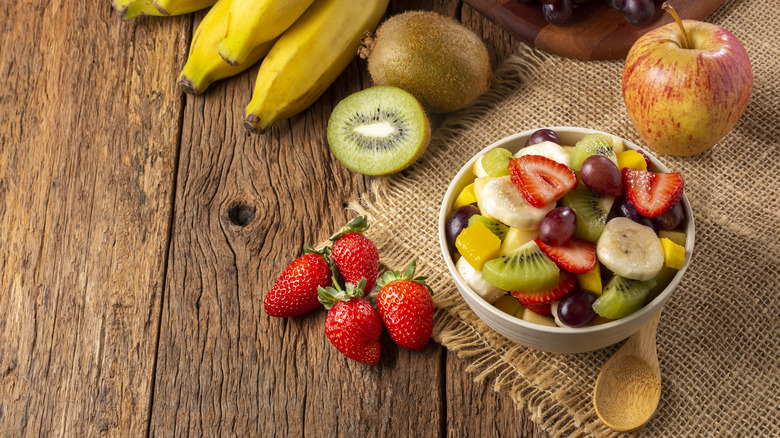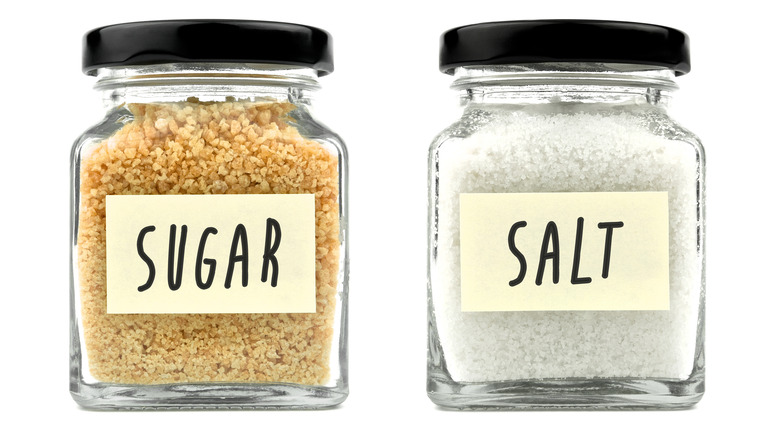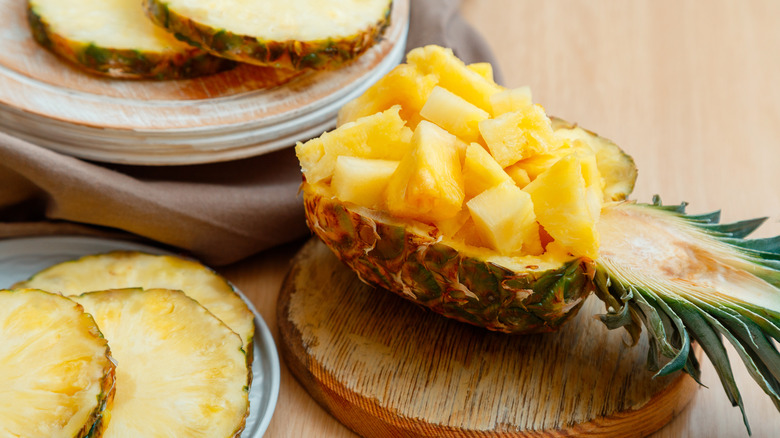The Sugar And Salt Trick For More Flavorful Out-Of-Season Fruit
Ah, summer, when fruits fall freely from laden branches, paraded in blazing color to farmstands and produce bins across the globe. They grace the season with a bounty of goodness, vying with their leafy-green, tuber, and cruciferous counterparts in the vegetable kingdom. But fresh fruits have relatively short heydays, meaning we end up with flavor expectations that fall shorter and shorter as fruit-bearing seasons turn.
Fortunately, there are a few ways to counteract the time constraints of Mother Nature. She's unlikely to extend the fresh-fruit seasons to satisfy mere humans, but we have a few tricks up our sleeves. When it comes to getting the juiciest flavor out of fruit that's technically out of season, some very simple pantry staples hold transformer status.
It's a given that sugar turns even the tartest lemon juice into fresh, sweet lemonade. It can also convert limes into crave-worthy key lime pies and transform sour, tart cranberries into holiday table stars. But sugar is only part of the flavor equation — as it turns out, another sprinkley white substance holds considerable sway over the tastiness of certain fruits.
Salt and sugar: an unlikely alliance
Whoever said, "My fruit salad lacks a little luster; bring me some salt"? Plenty of people, actually. That's because salt can perk up a piece of fruit in a hot minute, interacting with the natural sweetness in unexpected ways.
The American South is known for some quirky culinary tendencies, including dashing salt in surprising places. At first glance, at least to unsuspecting Yankees, coating a watermelon slice with salt can seem counterintuitive. After all, the sweetness of a watermelon is what makes it one of the South's favorite earth offerings on hot summer days. But sodium can enhance that sweetness rather than reduce it, and the principle applies similarly to other fruits.
A light dusting of salt on watermelon makes the fruit taste better, and it works by balancing the inherent flavors. Watermelons in particular harbor sour, sweet, and bitter flavors that are diminished by the large amount of water within the edible flesh. Since salt reduces the bitter flavors, the sweet ones come to the forefront and take center stage on your taste buds.
Especially when fruit is out of season, it's a good idea to use this little trick to enhance sweetness and flavor to entice you to continue consuming these vitamin-packed, health-inducing fruity morsels.
As science would have it
A bit of science highlights how salt reacts with juicy fruits such as melons. The thousands of tiny cells within the fruit have semipermeable membranes, allowing the fruit's water to enter and exit the cells. Since salt pulls water toward itself, adding a small amount to the surface of a sliced watermelon draws water and accompanying flavor to the first-bite area. Voilà! The sweetness gets the upper hand. Just go easy on the sodium; a heavy shake can leave a wet, salty mess in your mouth.
The same principle works with other fruits as well, particularly ones with naturally bitter components, such as pineapples. A sprinkle of salt balances the tropical fruit's flavors, intensifying the sweetness while also accomplishing another feat. It reduces that stinging mouthfeel that most people report when eating fresh pineapple chunks.
The phenomenon revolves around an enzyme in pineapples called bromelain that breaks down proteins, including the ones in your mouth. But salting the pineapple prior to consumption activates the bromelain and diminishes its impact before it enters your body.
Whichever type of fruit you're salting, experiment with standard table salt, kosher salt, or Himalayan pink salt, or try very briefly dipping the pieces in saltwater. You'll likely find that sweetness reigns once again on your palette and in your bowl of fruit.


